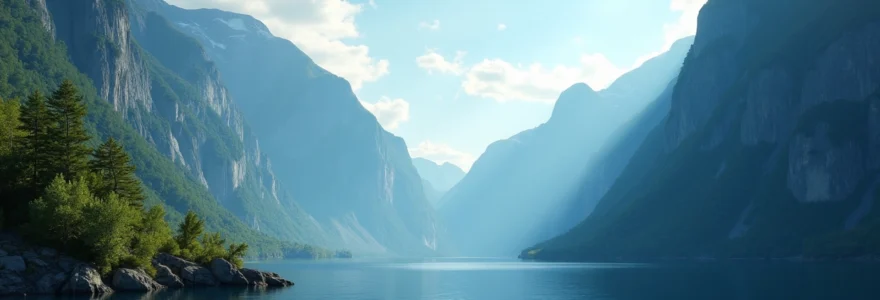Norway’s fjords are a testament to nature’s raw power and beauty, sculpted over millennia by glacial forces. These deep, narrow inlets flanked by towering cliffs offer some of the most breathtaking scenery on Earth. Exploring these majestic waterways by boat provides an unparalleled opportunity to immerse yourself in the heart of Norway’s natural wonders, witness diverse ecosystems, and experience the rich cultural heritage of fjord-side communities.
Geological formation of norwegian fjords: glacial erosion and tectonic activity
The formation of Norway’s fjords is a fascinating geological tale that spans millions of years. These dramatic landscapes are primarily the result of glacial erosion during successive ice ages, combined with the region’s unique tectonic history. As massive ice sheets advanced and retreated, they carved deep U-shaped valleys into the bedrock, which were later flooded by rising sea levels as the ice melted.
Tectonic activity played a crucial role in setting the stage for fjord formation. The uplift of the Scandinavian Mountains created the necessary elevation difference for glaciers to form and flow, while fault lines provided weak points for the ice to exploit. This interplay between glacial erosion and tectonic forces resulted in the intricate network of fjords we see today.
The depth of many Norwegian fjords is truly astounding, with some reaching over 1,000 meters below sea level. This depth, combined with the narrow width and steep sides, creates a unique marine environment that supports a diverse array of life forms, from microscopic plankton to large marine mammals.
Navigating the fjords: maritime challenges and vessel selection
Sailing through Norway’s fjords presents a set of unique challenges that require skill, experience, and the right equipment. The combination of deep waters, narrow passages, and ever-changing weather conditions demands careful navigation and thorough planning.
Tidal patterns and currents in sognefjord and geirangerfjord
Understanding tidal patterns and currents is crucial for safe navigation in fjords. In Sognefjord, Norway’s longest and deepest fjord, tidal variations can create strong currents, especially in narrow sections. Similarly, Geirangerfjord experiences significant tidal flows that can affect vessel maneuverability. Experienced captains must factor these hydrodynamic forces into their navigation plans to ensure safe passage.
Optimal boat types: from RIBs to expedition cruisers
The choice of vessel for fjord exploration depends on various factors, including the specific fjord’s characteristics, the purpose of the journey, and the season. Rigid Inflatable Boats (RIBs) offer agility and speed, ideal for short excursions and getting close to waterfalls. For longer journeys, expedition cruisers provide comfort and stability while navigating through larger fjords. Traditional sightseeing boats strike a balance, offering panoramic views and moderate capacity.
Seasonal considerations: ice conditions and daylight hours
Seasonal variations significantly impact fjord navigation. Winter months bring challenges such as reduced daylight hours and potential ice formation in northern fjords. Summer offers extended daylight, allowing for longer exploration periods. However, increased tourist traffic during peak season requires additional vigilance. Spring and autumn present their own unique conditions, with changing water levels due to snowmelt and varying weather patterns.
Navigation technology: echo sounders and GPS in fjord exploration
Modern navigation technology plays a vital role in safe fjord exploration. Echo sounders are indispensable for accurately measuring water depth, especially in areas where traditional charts may be less reliable due to changing underwater topography. GPS systems, integrated with detailed fjord maps, ensure precise positioning and route planning. Advanced weather monitoring systems help captains anticipate and prepare for rapidly changing conditions typical of fjord environments.
Iconic norwegian fjords: characteristics and attractions
Norway boasts an impressive array of fjords, each with its own distinct character and allure. From UNESCO World Heritage sites to fjords renowned for their dramatic landscapes, these natural wonders offer diverse experiences for visitors.
Nærøyfjord: UNESCO world heritage site and narrow passages
Nærøyfjord, a branch of the larger Sognefjord, is renowned for its narrow passages and towering cliffs. As a UNESCO World Heritage site, it exemplifies the outstanding natural beauty of Norway’s fjord landscapes. The fjord’s width narrows to just 250 meters in some sections, creating an intimate and awe-inspiring journey between 1,700-meter-high mountain walls. The area’s preserved natural and cultural landscapes make it a prime destination for eco-tourism and nature photography.
Lysefjord: home to preikestolen and kjeragbolten
Lysefjord is famous for its dramatic geological features, most notably Preikestolen (Pulpit Rock) and Kjeragbolten. Preikestolen, a flat-topped cliff rising 604 meters above the fjord, offers one of Norway’s most iconic views. Kjeragbolten, a boulder wedged in a mountain crevice, attracts thrill-seekers from around the world. The fjord’s name, meaning “light fjord,” comes from the light-colored granite rocks that line its walls, creating a striking contrast with the deep blue waters.
Hardangerfjord: apple orchards and vøringsfossen waterfall
Hardangerfjord, often referred to as the “Queen of the Fjords,” is Norway’s second-longest fjord and is celebrated for its diverse attractions. The region is famous for its apple orchards, which burst into bloom in spring, creating a picturesque landscape. The majestic Vøringsfossen waterfall, with a total drop of 182 meters, is a highlight of the area. Hardangerfjord also offers excellent opportunities for hiking, fishing, and cultural experiences in charming fjord-side villages.
Trollfjord: steep cliffs and rich wildlife habitat
Trollfjord, located in the Lofoten archipelago, is a small but spectacularly dramatic fjord. Its entrance is a mere 100 meters wide, flanked by near-vertical mountain walls rising to heights of over 1,000 meters. This narrow passage creates a unique microclimate that supports a rich ecosystem, making Trollfjord a prime habitat for sea eagles and other wildlife. The fjord’s name comes from Norwegian folklore, with its imposing landscape easily evoking images of mythical trolls.
Flora and fauna of norwegian fjords: ecosystems and conservation
The Norwegian fjords host a remarkable variety of ecosystems, from the depths of their waters to the peaks of surrounding mountains. These diverse habitats support an array of plant and animal species, many of which are unique to the fjord environment.
In the waters of the fjords, you’ll find a rich marine life including various species of fish, such as cod, herring, and salmon. Deeper waters are home to cold-water corals, while closer to the surface, seals and porpoises are common sights. The fjords also serve as important feeding grounds for whales, with species like orcas and humpbacks frequently spotted in certain areas.
On land, the steep cliffs and surrounding forests provide habitats for diverse flora and fauna. Alpine plants thrive in the harsh conditions of higher altitudes, while lower slopes are often covered in lush forests of pine and birch. Wildlife in these areas includes animals like red deer, mountain goats, and a variety of bird species, including the majestic white-tailed eagle.
Conservation efforts in Norwegian fjords focus on maintaining the delicate balance between human activity and natural ecosystems. Sustainable tourism practices and marine protected areas play crucial roles in preserving these unique environments for future generations.
The fjords face environmental challenges, including the impacts of climate change and potential overexploitation. Efforts to monitor water quality, regulate fishing, and manage tourism are ongoing to ensure the long-term health of these ecosystems.
Cultural heritage: fjord-side villages and norse mythology
The fjords of Norway are not just natural wonders; they are also steeped in rich cultural heritage. From ancient Norse mythology to traditional fjord-side villages, these waterways have shaped Norwegian culture for millennia.
Flåm: railway journey and viking history
The village of Flåm, nestled at the inner end of the Aurlandsfjord, offers a unique blend of natural beauty and cultural experiences. The world-famous Flåm Railway, one of the steepest standard gauge railway lines in the world, offers breathtaking views of the surrounding fjord landscape. The area also boasts a rich Viking history, with nearby archaeological sites and museums offering insights into Norse culture and traditions.
Geiranger: abandoned farms and skageflå mountain ledge
Geiranger, a small tourist village at the head of the Geirangerfjord, is surrounded by some of Norway’s most spectacular scenery. The fjord is dotted with abandoned farm settlements perched precariously on mountain ledges, testament to the hardy life of fjord dwellers in centuries past. The Skageflå farm, accessible only by boat or a challenging hike, offers visitors a glimpse into this unique cultural landscape.
Undredal: goat cheese production and stave church architecture
The tiny village of Undredal, on the Aurlandsfjord, is renowned for its traditional goat cheese production and its beautifully preserved stave church. This picturesque settlement, with just over 100 human residents and 500 goats, exemplifies the enduring traditions of fjord life. The Undredal Stave Church, one of the smallest in Norway, stands as a testament to the unique architectural style developed in medieval Scandinavia.
Throughout the fjord regions, you’ll find evidence of Norse mythology woven into place names, local legends, and traditional festivals. Many fjords and mountains bear names associated with gods, giants, and other mythical beings from Norse sagas, reflecting the deep connection between the landscape and ancient beliefs.
Environmental impact and sustainable tourism in norwegian fjords
As the popularity of fjord tourism grows, so does the concern for its environmental impact. Balancing the economic benefits of tourism with the need to preserve these pristine environments is a critical challenge facing Norway’s fjord regions.
Efforts to promote sustainable tourism in the fjords include the development of eco-friendly transportation options , such as electric ferries and hybrid cruise ships. These initiatives aim to reduce emissions and minimize the impact on marine life. Additionally, many fjord communities are implementing waste management programs and encouraging responsible tourist behaviors to protect the local ecosystem.
The Norwegian government has introduced regulations to limit the number of large cruise ships in certain fjords, particularly in UNESCO World Heritage sites like Geirangerfjord and Nærøyfjord. These measures aim to reduce air and noise pollution while preserving the tranquil atmosphere that makes these destinations so special.
Sustainable tourism in Norwegian fjords is not just about environmental protection; it’s also about preserving local cultures and economies. Many initiatives focus on promoting authentic experiences that benefit local communities while educating visitors about the importance of conservation.
Visitors to Norway’s fjords can contribute to sustainability efforts by choosing eco-certified accommodations, participating in responsible wildlife watching tours, and respecting local guidelines for waste disposal and resource conservation. By embracing these practices, tourists can help ensure that the fjords remain pristine and accessible for generations to come.
As we continue to explore and marvel at the beauty of Norway’s fjords, it’s crucial to remember our role in preserving these natural wonders. Through responsible tourism and ongoing conservation efforts, we can help maintain the delicate balance between human enjoyment and environmental protection in these extraordinary landscapes.


